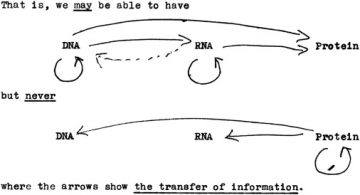Matthew Cobb in Current Biology:
 On May 13, 1961, two articles appeared in Nature, authored by a total of nine people, including Sydney Brenner, François Jacob and Jim Watson, announcing the isolation of messenger RNA (mRNA) 1, 2. In the same month, François Jacob and Jacques Monod published a review in Journal of Molecular Biology in which they put mRNA into a theoretical context, arguing for its role in gene regulation [3]. Aside from the technical prowess involved, these papers were feats of the imagination, for they represented an entirely new way of thinking about gene function.
On May 13, 1961, two articles appeared in Nature, authored by a total of nine people, including Sydney Brenner, François Jacob and Jim Watson, announcing the isolation of messenger RNA (mRNA) 1, 2. In the same month, François Jacob and Jacques Monod published a review in Journal of Molecular Biology in which they put mRNA into a theoretical context, arguing for its role in gene regulation [3]. Aside from the technical prowess involved, these papers were feats of the imagination, for they represented an entirely new way of thinking about gene function.
Although insight and hard thinking played a decisive role in developing this new view of life, this work built upon over a decade of research by many groups in the US and Europe as they attempted to unravel how the genetic message gets from DNA to produce proteins. We can reconstruct what happened in these years not only by studying the papers that were produced, but also by examining the reminiscences of those who were involved, both in their memoirs 4, 5, 6, 7, 8 and in oral histories [9], including talks by participants at the conference on the history of mRNA that took place in August 2014 as part of the Cold Spring Harbor Laboratory Genentech Center Conferences on the History of Molecular Biology and Biotechnology.
The acceptance of the genetic role of DNA began in 1944 with the publication of Avery, McLeod and McCarty’s first paper on the identification of the ‘transforming principle’ in pneumococcal bacteria as DNA 10, 11. For much of the 1950s, the suggestion that DNA was the hereditary material in all organisms was accepted as a ‘working hypothesis’ but nothing more — as late as 1961 a paper in Nature left the door open to the possibility that genes were made of proteins, not DNA [12]. One of the continuous concerns throughout this period was that it remained unclear how genes functioned.
A key insight came in 1953, when Watson and Crick suggested that the sequence of bases on a DNA molecule contains ‘genetical information’ [13]. The issue then became how that information was turned into biological function — the nature of the genetic code and how it worked. The person initially responsible for focusing attention on this problem was the cosmologist George Gamow.
More here.
